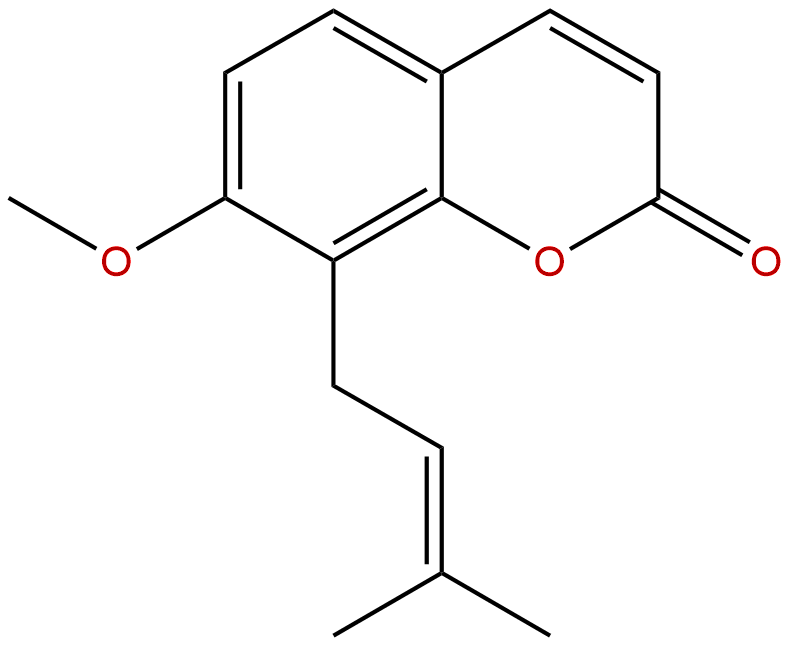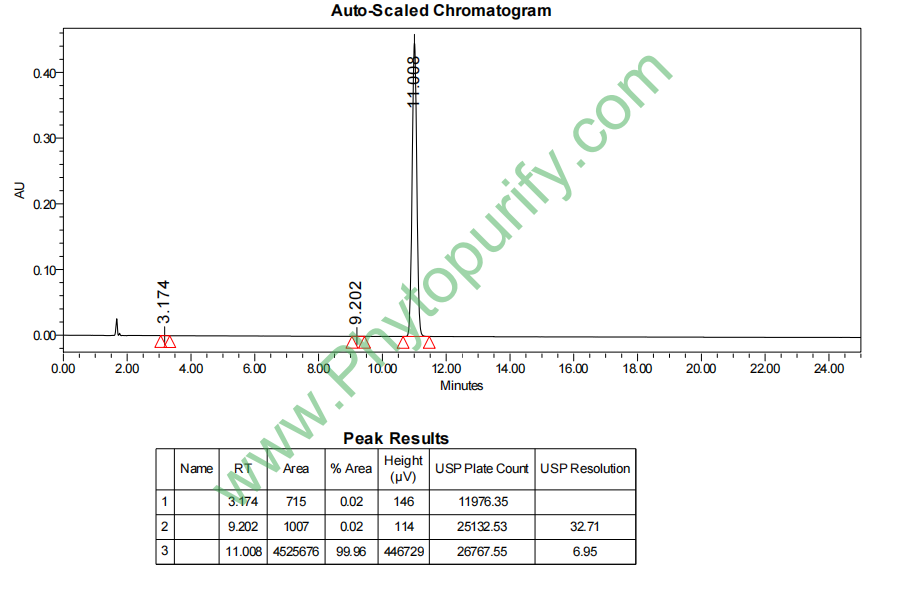
OstholCAS No.:484-12-8
|
||||||||||
 |
|
|
||||||||

| Catalogue No.: | BP1047 |
| Formula: | C15H16O3 |
| Mol Weight: | 244.29 |
Product name: Osthol
Synonym name: Osthenol methylether
Catalogue No.: BP1047
Cas No.: 484-12-8
Formula: C15H16O3
Mol Weight: 244.29
Botanical Source: Cnidium monnieri(L.)Cuss.
Physical Description:
Type of Compound: Coumarins
Purity: 95%~99%
Analysis Method: HPLC-DAD or/and HPLC-ELSD
Identification Method: Mass, NMR
Packing: Brown vial or HDPE plastic bottle
Storage: Store in a well closed container, protected from air and light. Put into refrigerate or freeze for long term storage.
Whenever possible, you should prepare and use solutions on the same day. However, if you need to make up stock solutions in advance, we recommend that you store the solution as aliquots in tightly sealed vials at -20℃. Generally, these will be useable for up to two weeks.
The product could be supplied from milligrams to grams
Inquire for bulk scale.
Description:
Osthol is a natural antihistamine alternative, may be a potential inhibitor of histamine H1 receptor activity. Osthol has toxicity, may be used as bio-pesticides. Osthol is an inhibitor of human Pgp and multidrug efflux pumps of Staphylococcus aureus , reversing the resistance against frontline antibacterial drugs.Osthol has anti-allergic, antiosteoporosis, anti-fatty liver, antitumor, and cardioprotective effects. Osthol inhibits hepatic SREBP-1c/2 mRNA expressions and subsequent modulation of SREBP-1c/2-mediated target genes such as FAS, CYP7A and LDL receptor; it can stimulate the osteoblastic differentiation of rat calvarial osteoblast cultures by the BMP-2/p38MAPK/Runx-2/osterix pathway.
References:
Environ Health Toxicol. 2014 Dec 10;29:e2014020.
Acute toxicity assessment of Osthol content in bio-pesticides using two aquatic organisms.
This study focused on the assessment of acute toxicity caused by Osthol, a major component of environment-friendly biological pesticides, by using two aquatic organisms.
METHODS AND RESULTS:
The assessment of acute toxicity caused by Osthol was conducted in Daphnia magna and by examining the morphological abnormalities in Danio rerio embryos. The median effective concentration value of Osthol in D. magna 48 hours after inoculation was 19.3 μM. The median lethal concentration of D. rerio embryo at 96 hours was 30.6 μM. No observed effect concentration and predicted no effect concentration values of Osthol in D. magna and D. rerio were calculated as 5.4 and 0.19 μM, respectively. There was an increase in the morphological abnormalities in D. rerio embryo due to Osthol over time. Coagulation, delayed hatching, yolk sac edema, pericardial edema, and pigmentation were observed in embryos at 24-48 hours. Symptoms of scoliosis and head edema occurred after 72 hours. In addition, bent tails, ocular defects, and symptoms of collapse were observed in fertilized embryo tissue within 96 hours. Ocular defects and pigmentation were the additional symptoms observed in this study.
CONCLUSIONS:
Because Osthol showed considerable toxicity levels continuous toxicity evaluation in agro-ecosystems is necessary when bio-pesticides containing Osthol are used.
Phytother Res. 2007 Mar;21(3):226-30.
Antitumor effects of Osthol from Cnidium monnieri: an in vitro and in vivo study.
Cnidium monnieri (L.) Cusson is a Chinese medicine which is used widely by traditional medicine doctors. Osthol is a major bio-activity compound of the herb.
METHODS AND RESULTS:
In this study, Osthol was isolated from C. monnieri and its in vitro and in vivo antitumor effects studied. The results of the in vitro study showed: that Osthol inhibited the growth of HeLa, in a time- and concentration-dependent manner, with IC(50) values of 77.96 and 64.94 microm for 24 and 48 h, respectively; that Osthol had lower cytotoxic effects in primary cultured normal cervical fibroblasts; and that increased DNA fragmentation and activated PARP in HeLa after treatment with Osthol which could induce apoptosis. The results of the in vivo model showed that the survival days of the P-388 D1 tumor-bearing CDF(1) mice were prolonged (ILS% = 37) after Osthol (30 mg/kg) was given once a day for 9 days.
CONCLUSIONS:
Based on these results, it is suggested that Osthol could inhibit P-388 D1 cells in vivo and induce apoptosis in HeLa cells in vitro, and that Osthol is good lead compound for developing antitumor drugs. However, C. formosanum Yabe of Taiwan's endemic plants contained little Osthol, with no imperatorin, and its major components were different from that of C. monnieri. Therefore, it is suggested that C. formosanum also may possess economic worth.
World J Gastroenterol. 2014 Sep 7;20(33):11753-61.
Osthol attenuates hepatic steatosis via decreased triglyceride synthesis not by insulin resistance.
To evaluate the effects of Osthol on intrahepatic fat synthesis, β-oxidation, inflammation, and insulin resistance by multifaceted analysis.
METHODS AND RESULTS:
Sprague-Dawley rats (n = 30) were randomly divided into control, non-alcoholic fatty liver disease (NAFLD), and Osthol groups. NAFLD and Osthol groups were fed with a high-fat diet for 14 wk. After 8 wk of the high-fat diet, the Osthol group also received Osthol 20 mg/kg orally 5 times/wk. To assess the insulin resistance, oral glucose tolerance was performed at the end of 14 wk. Immunohistochemical (4-HNE, F4/80) and hematoxylin and eosin (HE) staining were performed on liver tissue extracts after animal sacrifice at 14 wk. SREBP1c, FAS, SCD-1, PPAR-α, CROT, MCP-1, IRS-1, and IRS-2 mRNA expressions were assessed with reverse transcription-polymerase chain reaction. HE staining revealed that, compared with the NAFLD group, the Osthol group showed significantly decreased intrahepatic fat content (39.4% vs 21.0%; P = 0.021). SREBP1c expression in the NAFLD group increased compared to controls (P = 0.0001), while Ostholtreatment decreased SREBP1c expression compared with the NAFLD group (P = 0.0059). In the Osthol group, intrahepatic FAS and SCD-1, which act downstream of SREBP1c, decreased significantly compared with the NAFLD group. Moreover, PPAR-α expression in the Osthol group was also significantly higher than in the NAFLD group (P = 0.0147).
CONCLUSIONS:
Osthol treatment attenuated liver steatosis by decreasing de novo liver triglyceride synthesis and had nominal effects on insulin resistance and liver inflammation.
Lipids. 2012 Oct;47(10):987-94.
Reduction of rat cardiac hypertrophy by osthol is related to regulation of cardiac oxidative stress and lipid metabolism.
The objective of this study was to examine the therapeutic effect of Osthol, a coumarin compound isolated from the fruit of Cnidium monnieri (L.) Cusson, on cardiac hypertrophy in rats and investigate its potential mechanisms.
CONCLUSIONS:
The rats with cardiac hypertrophy induced by renovascular hypertension were given Osthol orally by gavage for 4 weeks. The results showed that in the Osthol 20 mg/kg group, the blood pressure, heart weight index and myocardial malondialdehyde content were lowered (p < 0.001, p = 0.002 and p = 0.025, respectively), the myocardial superoxide dismutase and glutathione peroxidase contents were increased (p < 0.001), and the elevated unesterified fatty acids and triacylglycerols in myocardial tissues were decreased (p = 0.017 and p = 0.004, respectively). At the same time, the myocardial peroxisome proliferator-activated receptor (PPAR)-α and carnitine palmitoyltransferase (CPT)-1a mRNA expressions were increased and the myocardial diacylglycerol acyltransferase (DGAT) mRNA expression was decreased in the Osthol 20 mg/kg group (p < 0.001). Osthol treatment was associated with a decreased cross-sectional area of cardiomyocytes (p < 0.001).
CONCLUSIONS:
These findings suggest that Osthol may exert a therapeutic effect on cardiac hypertrophy in rats, and its mechanisms may be related to the improvement of myocardial oxidative stress and lipid metabolism via regulation of PPARα-mediated target gene expressions including an increase in CPT-1a mRNA expression and a decrease in DGAT mRNA expression.
HPLC of Osthol
